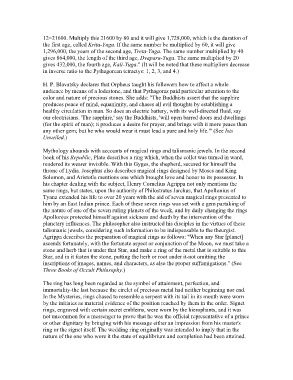Page 275 - The_secret_teachings_of_all_ages_Neat
P. 275
12=21600. Multiply this 21600 by 80 and it will give 1,728,000, which is the duration of
the first age, called Krita-Yuga. If the same number be multiplied by 60, it will give
1,296,000, the years of the second age, Treta-Yuga. The same number multiplied by 40
gives 864,000, the length of the third age, Dvapara-Yuga. The same multiplied by 20
gives 432,000, the fourth age, Kali-Yuga." (It will be noted that these multipliers decrease
in inverse ratio to the Pythagorean tetractys: 1, 2, 3, and 4.)
H. P. Blavatsky declares that Orpheus taught his followers how to affect a whole
audience by means of a lodestone, and that Pythagoras paid particular attention to the
color and nature of precious stones. She adds: "The Buddhists assert that the sapphire
produces peace of mind, equanimity, and chases all evil thoughts by establishing a
healthy circulation in man. So does an electric battery, with its well-directed fluid, say
our electricians. 'The sapphire,' say the Buddhists, 'will open barred doors and dwellings
(for the spirit of man); it produces a desire for prayer, and brings with it more peace than
any other gem; but he who would wear it must lead a pure and holy life."' (See Isis
Unveiled.)
Mythology abounds with accounts of magical rings and talismanic jewels. In the second
book of his Republic, Plato describes a ring which, when the collet was turned in ward,
rendered its wearer invisible. With this Gyges, the shepherd, secured for himself the
throne of Lydia. Josephus also describes magical rings designed by Moses and King
Solomon, and Aristotle mentions one which brought love and honor to its possessor. In
his chapter dealing with the subject, Henry Cornelius Agrippa not only mentions the
same rings, but states, upon the authority of Philostratus Jarchus, that Apollonius of
Tyana extended his life to over 20 years with the aid of seven magical rings presented to
him by an East Indian prince. Each of these seven rings was set with a gem partaking of
the nature of one of the seven ruling planets of the week, and by daily changing the rings
Apollonius protected himself against sickness and death by the intervention of the
planetary influences. The philosopher also instructed his disciples in the virtues of these
talismanic jewels, considering such information to be indispensable to the theurgist.
Agrippa describes the preparation of magical rings as follows: "When any Star [planet]
ascends fortunately, with the fortunate aspect or conjunction of the Moon, we must take a
stone and herb that is under that Star, and make a ring of the metal that is suitable to this
Star, and in it fasten the stone, putting the herb or root under it-not omitting the
inscriptions of images, names, and characters, as also the proper suffumigations." (See
Three Books of Occult Philosophy.)
The ring has long been regarded as the symbol of attainment, perfection, and
immortality-the last because the circlet of precious metal had neither beginning nor end.
In the Mysteries, rings chased to resemble a serpent with its tail in its mouth were worn
by the initiates as material evidence of the position reached by them in the order. Signet
rings, engraved with certain secret emblems, were worn by the hierophants, and it was
not uncommon for a messenger to prove that he was the official representative of a prince
or other dignitary by bringing with his message either an impression from his master's
ring or the signet itself. The wedding ring originally was intended to imply that in the
nature of the one who wore it the state of equilibrium and completion had been attained.

